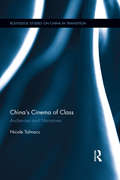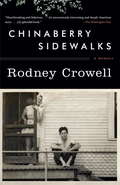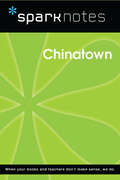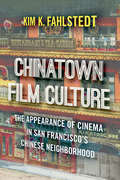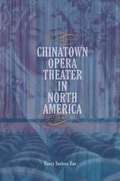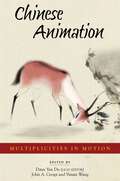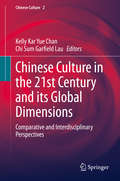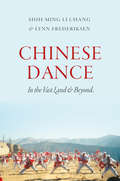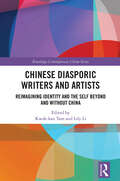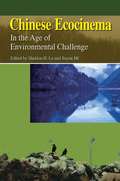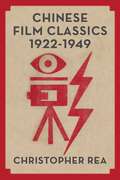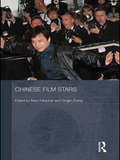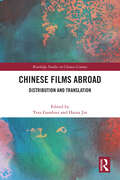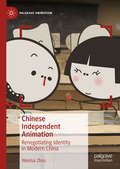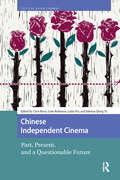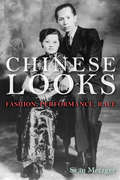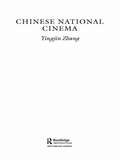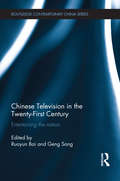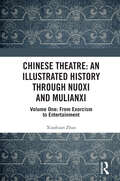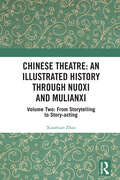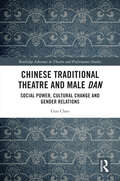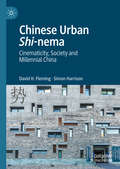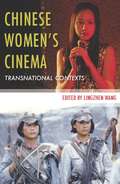- Table View
- List View
China's Cinema of Class: Audiences and Narratives (Routledge Studies on China in Transition)
by Nicole TalmacsChina’s commercial film industry can be used as a map to understand how class is interwoven into the imaginations that inform and influence social change in Chinese society. Film consumption is important in this process, particularly for young adult urbanites that are China’s primary commercial cinema patrons. This book investigates the web between the representation of class themes in Chinese film narratives, local audience reception to these films, and the socialisation of China’s contemporary class society. Bringing together textual analyses of narratives from five commercially exhibited films: Let the Bullets Fly (Jiang: 2010), Lost on Journey (Yip: 2011), Go Lala Go! (Xu: 2011), House Mania (Sun: 2011) and The Piano in the Factory (Zheng: 2011); and the reception of 179 Chinese audiences from varying class positions, it investigates the extent to which fictional narratives inform and reflect current class identities in present-day China. Through group discussions in Beijing, Hangzhou, Nanjing, Lanzhou and Taiyuan, the author searches for audiences beyond major cities that are typically the focus of film consumption studies in China. As such, the book reveals not only how deeply and widespread the socialisation of China’s class society has become in the imaginations of Chinese audiences, but also what appears to be a preference of both audiences and filmmakers for the continuation of China’s new class society. Revealing the extent to which cinema continues to play a key role in the socialisation of class structures in contemporary Chinese society, this book will be important for students and scholars of Chinese Studies, Film Studies, Communication Studies, as well as observers of China’s film industry.
Chinaberry Sidewalks
by Rodney CrowellFrom the acclaimed musician comes a tender, surprising, and often uproarious memoir about his dirt-poor southeast Texas boyhood. The only child of a hard-drinking father and a Holy Roller mother, Rodney Crowell was no stranger to bombast from an early age, whether knock-down-drag-outs at a local dive bar or fire-and-brimstone sermons at Pentecostal tent revivals. He was an expert at reading his father's mercurial moods and gauging exactly when his mother was likely to erupt, and even before he learned to ride a bike, he was often forced to take matters into his own hands. He broke up his parents' raucous New Year's Eve party with gunfire and ended their slugfest at the local drive-in (actual restaurants weren't on the Crowells' menu) by smashing a glass pop bottle over his own head. Despite the violent undercurrents always threatening to burst to the surface, he fiercely loved his epilepsy-racked mother, who scorned boring preachers and improvised wildly when the bills went unpaid. And he idolized his blustering father, a honky-tonk man who took his boy to see Hank Williams, Jerry Lee Lewis, Carl Perkins, and Johnny Cash perform live, and bought him a drum set so he could join his band at age eleven. Shot through with raggedy friends and their neighborhood capers, hilariously awkward adolescent angst, and an indelible depiction of the bloodlines Crowell came from, Chinaberry Sidewalks also vividly re-creates Houston in the fifties: a rough frontier town where icehouses sold beer by the gallon on paydays; teeming with musical venues from standard roadhouses to the Magnolia Gardens, where name-brand stars brought glamour to a place starved for it; filling up with cheap subdivisions where blue-collar day laborers could finally afford a house of their own; a place where apocalyptic hurricanes and pest infestations were nearly routine. But at its heart this is Crowell's tribute to his parents and an exploration of their troubled yet ultimately redeeming romance. Wry, clear-eyed, and generous, it is, like the very best memoirs, firmly rooted in time and place and station, never dismissive, and truly fulfilling.
Chinatown (SparkNotes Film Guide)
by SparkNotesChinatown (SparkNotes Film Guide) Making the reading experience fun! SparkNotes Film Guides are one-stop guides to great works of film–masterpieces that are the foundations of filmmaking and film studies. Inside each guide you&’ll find thorough, insightful overviews of films from a variety of genres, styles, and time periods. Each film guide contains:Information about the director and the context in which the film was made Thoughtful analysis of major characters Details about themes, motifs, and symbols Explanations of the most important lines of dialogue In-depth discussions about what makes a film so remarkable SparkNotes Film Guides are an invaluable resource for students or anyone who wants to gain a deeper understanding of the great films they know and love.
Chinatown Film Culture: The Appearance of Cinema in San Francisco’s Chinese Neighborhood
by Kim K. FahlstedtChinatown Film Culture provides the first comprehensive account of the emergence of film and moviegoing in the transpacific hub of San Francisco in the early twentieth century. Working with materials previously left in the margins of grand narratives of history, Kim K. Fahlstedt uncovers the complexity of a local entertainment culture that offered spaces where marginalized Chinese Americans experienced and participated in local iterations of modernity. At the same time, this space also fostered a powerful Orientalist aesthetic that would eventually be exported to Hollywood by San Francisco showmen such as Sid Grauman. Instead of primarily focusing on the screen-spectator relationship, Fahlstedt suggests that immigrant audiences' role in the proliferation of cinema as public entertainment in the United States saturated the whole moviegoing experience, from outside on the street to inside the movie theater. By highlighting San Francisco and Chinatown as featured participants rather than bit players, Chinatown Film Culture provides an historical account from the margins, alternative to the more dominant narratives of U.S. film history.
Chinatown Opera Theater in North America
by Nancy Yunhwa RaoThe Chinatown opera house provided Chinese immigrants with an essential source of entertainment during the pre “World War II era. But its stories of loyalty, obligation, passion, and duty also attracted diverse patrons into Chinese American communities Drawing on a wealth of new Chinese- and English-language research, Nancy Yunhwa Rao tells the story of iconic theater companies and the networks and migrations that made Chinese opera a part of North American cultures. Rao unmasks a backstage world of performers, performance, and repertoire and sets readers in the spellbound audiences beyond the footlights. But she also braids a captivating and complex history from elements outside the opera house walls: the impact of government immigration policy; how a theater influenced a Chinatown's sense of cultural self; the dissemination of Chinese opera music via recording and print materials; and the role of Chinese American business in sustaining theatrical institutions. The result is a work that strips the veneer of exoticism from Chinese opera, placing it firmly within the bounds of American music and a profoundly American experience.
Chinese Animation: Multiplicities in Motion (Harvard East Asian Monographs #475)
by Daisy Yan DU, John A. CRESPI, Yiman WANGChinese Animation: Multiplicities in Motion is the first edited volume that explores the multiple histories, geographies, industries, technologies, media, and transmedialities of Chinese animation, from early animated special effects to socialist classics, from computer-generated-imagery (CGI) blockbusters to edgy independent films, and from stop-motion to virtual reality.Its fifteen chapters, grouped under the five themes of junctures, gender, identities, digitality, and practices, span a century of animation since the 1920s across mainland China, Hong Kong, Taiwan, Singapore, and the diasporic world. Derived from the 2021 Inaugural Conference of the Association for Chinese Animation Studies (ACAS), this volume as a whole defines Chinese animation studies as a new field of research emerging from the peripheries of modern Chinese literature and film studies on the one hand, and from the margins of Western and Japanese animation studies on the other. Incorporating diverse academic approaches and perspectives, this groundbreaking book is an indispensable guide for a rapidly growing community of scholars, students, animators, fans, and general readers interested in Chinese and world animation.
Chinese Culture in the 21st Century and its Global Dimensions: Comparative and Interdisciplinary Perspectives (Chinese Culture #2)
by Kelly Kar Yue Chan Chi Sum Garfield LauThis book investigates the internationalization of Chinese culture in recent decades and the global dimensions of Chinese culture from comparative and interdisciplinary perspectives. It covers a variety of topics concerning the contemporary significance of Chinese culture in its philosophical, literary and artistic manifestations, including literature, film, performing arts, creative media, linguistics, translations and philosophical ideas. The book explores the reception of Chinese culture in different geographic locations and how the global reception of Chinese culture contrasts with the local Chinese community. The chapters collectively cover gender studies and patriarchal domination in Chinese literature in comparison to the world literature, explorations on translation of Chinese culture in the West, Chinese studies as an academic discipline in the West, and Chinese and Hong Kong films and performances in the global context. The book is an excellent resource for both scholars and students interested in the development of Chinese culture on the global stage in the 21st Century.
Chinese Dance: In the Vast Land and Beyond
by Emily Wilcox Lynn E. Frederiksen Shih-Ming Li ChangAs China becomes increasingly important in world relations, many components of the country's cultural arts remain unknown outside its borders. Shih-Ming Li Chang and Lynn E. Frederiksen's Chinese Dance: In the Vast Land and Beyond undertakes the challenge of discovering the relationship between Chinese dance in its many forms and the cultural contexts of dance within the region and abroad. As a comprehensive resource, Chinese Dance offers students and scholars an invaluable introduction to the subject. It serves as a foundation of common knowledge from which Chinese and English-language communities can begin a cross-cultural conversation about Chinese dance. The text, along with a comprehensive glossary of key terms, gives English-language readers a chance to understand the development of Chinese dance as it is officially articulated by historians and dance scholars in Asia. An online database of video clips, an extensive bibliography, and Web-based appendices provide a broad collection of primary source materials that invite interactive and flexible engagement by a range of users. The inclusion of interviews with Chinese dance practitioners in North America offers a view into the Asian diaspora experience.
Chinese Diasporic Writers and Artists: Reimagining Identity and the Self Beyond and Without China (Routledge Contemporary China Series)
by Kwok-Kan Tam Lily LiThis book presents new and original essays that capture the enigmatic and intriguing personal and imagined worlds of Chinese writers and artists in diaspora in the twentieth and twenty-first centuries.Including chapters on artist-writers such as Gao Xingjian, Dai Sijie, Ha Jin and Hong Ying, Tyrus Wong, and Shen Wei, the book explores personal cross-cultural experiences through their literary and other artistic works, reflecting on their cultural identity, their native home, and their new home, the past and the present. By writing, filming, and painting about their diaspora/diasporic experience, they are writing about their selves and the traumatic experience many of them have gone through in forgetting the past, forgiving the damage, and foreshadowing a future by re-visioning their selves. Their experience represents a generation’s quest for an identity of being Chinese but culturally distanced from China.As a study of cross-cultural human experience through the lens of literature, film, and other arts, this book will not only appeal to students and scholars of Chinese diaspora studies, it will also appeal to those with an interest in Chinese literature, film, and culture.
Chinese Ecocinema
by Sheldon H. LuThis anthology is the first book-length study of China's environmental condition and ecosystem through the lens of cinema from a non-anthropocentric point of view. By proposing "ecocinema" as a new critical framework, the volume breaks new ground in Chinese and global film studies.
Chinese Film Classics, 1922–1949
by Christopher G. ReaChinese Film Classics, 1922–1949 is an essential guide to the first golden age of Chinese cinema. Offering detailed introductions to fourteen films, this study highlights the creative achievements of Chinese filmmakers in the decades leading up to 1949, when the Communists won the civil war and began nationalizing cultural industries.Christopher Rea reveals the uniqueness and complexity of Republican China’s cinematic masterworks, from the comedies and melodramas of the silent era to the talkies and musicals of the 1930s and 1940s. Each chapter appraises the artistry of a single film, highlighting its outstanding formal elements, from cinematography to editing to sound design. Examples include the slapstick gags of Laborer’s Love (1922), Ruan Lingyu’s star turn in Goddess (1934), Zhou Xuan’s mesmerizing performance in Street Angels (1937), Eileen Chang’s urbane comedy of manners Long Live the Missus! (1947), the wartime epic Spring River Flows East (1947), and Fei Mu’s acclaimed work of cinematic lyricism, Spring in a Small Town (1948). Rea shares new insights and archival discoveries about famous films, while explaining their significance in relation to politics, society, and global cinema. Lavishly illustrated and featuring extensive guides to further viewings and readings, Chinese Film Classics, 1922–1949 offers an accessible tour of China’s early contributions to the cinematic arts.
Chinese Film Stars (Routledge Contemporary China Series)
by Mary FarquharThis volume of original essays fills a significant research gap in Chinese film studies by offering an interdisciplinary, comparative examination of ethnic Chinese film stars from the silent period to the era of globalization. Whereas studies of stars and stardom have developed considerably in the West over the past two decades, there is no single book in English that critically addresses issues related to stars and stardom in Chinese culture. Chinese Film Stars offers exemplary readings of historically, geographically and aesthetically multifaceted star phenomena. An international line up of contributors test a variety of approaches in making sense of discourses of stars and stardom in China and the US, explore historical contexts in which Chinese film stars are constructed and transformed in relation to changing sociopolitical conditions, and consider issues of performance and identity specific to individual stars through chapter-by-chapter case studies. The essays explore a wide range of topics such as star performance, character type, media construction, political propaganda, online discourses, autobiographic narration, as well as issues of gender, genre, memory and identity. Including fifteen case studies of individual Chinese stars and illustrated with film stills throughout, this book is an essential read for students of Chinese film, media and cultural studies.
Chinese Film: Realism and Convention from the Silent Era to the Digital Age
by Jason McGrathA tour de force chronicling the development of realism in Chinese cinema The history of Chinese cinema is as long and complicated as the tumultuous history of China itself. Be it the silent, the Communist, or the contemporary, each Chinese cinematic era has necessitated its own form in conversation with broader trends in politics and culture. In Chinese Film, Jason McGrath tells this fascinating story by tracing the varied claims to cinematic realism made by Chinese filmmakers, officials, critics, and scholars. Understanding realism as a historical dynamic that is both enabled and mitigated by aesthetic conventions of the day, he analyzes it across six different types of claims: ontological, perceptual, fictional, social, prescriptive, and apophatic.Through this method, McGrath makes major claims not just about Chinese cinema but also about realism as an aesthetic form that negotiates between cultural conventions and the ever-evolving real. He comes to envision it as more than just a cinematic question, showing how the struggle for realism is central to the Chinese struggle for modernity itself.
Chinese Films Abroad: Distribution and Translation (Routledge Studies in Chinese Cinema)
by Haina Jin Yves GambierThis book examines Chinese films made and shown abroad roughly between the 1920s and the 2020s, from the beginning of the international exchange of the Chinese national film industry to the emergence of the concept of soft power.The periodisation of Chinese cinema(s) does not necessarily match the political periods: on the one hand, the technical development of the film industry and the organisation of translation in China, and on the other hand, official relations with China and translation policies abroad impose different constraints on the circulation of Chinese films. This volume deals with the distribution and translation of films from mainland China, Taiwan, Hong Kong, and the Chinese diaspora. To this end, the contributors address various issues related to the circulation and distribution of Chinese films, including co- productions, agents of exchange, and modes of translation. The approach is a mixture of socio- cultural and translational methods. The data collected provides, for the first time, a quantitative overview of the circulation of Chinese films in a dozen foreign countries.The book will greatly interest scholars and students of Chinese cinema, translation studies, and China studies.
Chinese Independent Animation: Renegotiating Identity in Modern China (Palgrave Animation)
by Wenhai ZhouThis study of ‘independent’ animation opens up a quietly subversive and vibrant dimension of contemporary Chinese culture which, hitherto, has not received as much attention as dissident art or political activism. Scholarly interest in Chinese animation has increased over the last decade, with attention paid to the conventional media circle of production, distribution and consumption. The ‘independent’ sector has been largely ignored however, until now. By focusing on distinctive independent artists like Pisan and Lei Lei, and situating their work within the present day media ecology, the author examines the relationship between the genre and the sociocultural transformation of contemporary China. Animation, the author argues, has a special significance, as the nature of the animation text is itself multilayered and given to multiple interpretations and avenues of engagement. Through an examination of the affordances of this ‘independent’ media entity, the author explores how this multifaceted cultural form reveals ambiguities that parallel contradictions in art and society. In so doing, independent animation provides a convenient ‘mirror’ for examining how recent social upheavals have been negotiated, and how certain practitioners have found effective ways for discussing the post-Socialist reality within the current political configuration.
Chinese Independent Cinema: Past, Present, and a Questionable Future (Critical Asian Cinemas)
by Chris Berry Luke Robinson Sabrina Qiong Yu Lydia WuIndependent cinema in China is not only made outside the commercial system but also without being submitted for censorship. We know that for several decades it has been the crucible out of which China’s most exciting new films have flowed. The essays in this volume interrogate what else we think we know. Did it really start with Wu Wenguang and Bumming in Beijing in 1990, or can its roots be traced back much earlier? What are its aesthetics? And its ethics, including of gender and class? Where do audiences watch these films in China and how do they circulate? And, since the 2017 Film Law defined uncensored films as illegal, is independent Chinese cinema still alive? What does it mean today? And does it have a future? The essays in this anthology—many by exciting new scholars—explore these urgent questions.
Chinese Looks
by Sean MetzgerFrom yellow-face performance in the 19th century to Jackie Chan in the 21st, Chinese Looks examines articles of clothing and modes of adornment as a window on how American views of China have changed in the past 150 years. Sean Metzger provides a cultural history of three iconic objects in theatrical and cinematic performance: the queue, or man's hair braid; the woman's suit known as the qipao; and the Mao suit. Each object emerges at a pivotal moment in US-China relations, indexing shifts in the balance of power between the two nations. Metzger shows how aesthetics, gender, politics, economics, and race are interwoven and argues that close examination of particular forms of dress can help us think anew about gender and modernity.
Chinese National Cinema (National Cinemas #20)
by Yingjin ZhangThis introduction to Chinese national cinema covers three 'Chinas': mainland China, Hong Kong and Taiwan. Historical and comparative perspectives bring out the parallel developments in these three Chinas, while critical analysis explores thematic and stylistic changes over time. As well as exploring artistic achievements and ideological debates, Yingjin Zhang examines how - despite the pressures placed on the industry from state control and rigid censorship - Chinese national cinema remains incapable of projecting a single unified picture, but rather portrays many different Chinas.
Chinese Television in the Twenty-First Century: Entertaining the Nation (Routledge Contemporary China Series)
by Ruoyun Bai Geng SongThe past two decades witnessed the rise of television entertainment in China. Although television networks are still state-owned and Party-controlled in China, the ideological landscape of television programs has become increasingly diverse and even paradoxical, simultaneously subservient and defiant, nationalistic and cosmopolitan, moralistic and fun-loving, extravagant and mundane. Studying Chinese television as a key node in the network of power relationships, therefore, provides us with a unique opportunity to understand the tension-fraught and , paradox-permeated conditions of Chinese post-socialism. This book argues for a serious engagement with television entertainment. rethinking, It addresses the following questions. How is entertainment television politically and culturally significant in the Chinese context? How have political, industrial, and technological changes in the 2000s affected the way Chinese television relates to the state and society? How can we think of media regulation and censorship without perpetuating the myth of a self-serving authoritarian regime vs. a subdued cultural workforce? What do popular televisual texts tell us about the unsettled and reconfigured relations between commercial television and the state? The book presents a number of studies of popular television programs that are sensitive to the changing production and regulatory contexts for Chinese television in the twenty-first century. As an interdisciplinary study of the television industry, this book covers a number of important issues in China today, such as censorship, nationalism, consumerism, social justice, and the central and local authorities. As such, it will appeal to a broad audience including students and scholars of Chinese culture and society, media studies, television studies, and cultural studies.
Chinese Theatre: Volume One: From Exorcism to Entertainment
by Xioahuan ZhaoChinese Theatre: An Illustrated History Through Nuoxi and Mulianxi is the first book in any language entirely devoted to a historical inquiry into Chinese theatre through Nuoxi and Mulianxi, the two most representative and predominant forms of Chinese temple theatre. With a view to evaluating the role of temple theatre in the development of xiqu or traditional Chinese theatre and drama from myth to ritual to ritual drama to drama, Volume One provides a panoramic perspective that allows every aspect of Nuoxi to be considered, not in the margins of xiqu but in and of itself. Thus, this volume traces xiqu history from its shamanic roots in exorcism rituals of Nuo to various forms of ritual and theatrical performance presented at temple fairs, during community and calendrical festivals or for ceremonial functions over the course of imperial history, and into the twenty-first century, followed by an exploration of the scriptural origins and oral traditions of Mulianxi, with pivotal forms and functions of Nuoxi and Mulian storytelling, examined, explicated and illustrated in association with the development of corresponding genres of Chines performance literature and performing arts. This is an interdisciplinary book project that is aimed to help researchers and students of theatre history understand the ritual origins of Chinese theatre and the dynamic relationships among myth, ritual, religion, and theatre.
Chinese Theatre: Volume Two: From Storytelling to Story-acting
by Xiaohuan ZhaoChinese Theatre: An Illustrated History Through Nuoxi and Mulianxi is the first book in any language entirely devoted to a historical inquiry into Chinese theatre through Nuoxi and Mulianxi, the two most representative and predominant forms of Chinese temple theatre. Volume Two is a continuation of the historical inquiry into Chinese theatre with focus shifted from Mulian storytelling to Mulian story-acting. Thus, this volume traces the historical trajectory of xiqu from Northern dramas to Southern dramas and from elite court theatre to mass regional theatre with pivotal forms and functions of Mulianxi examined, explicated and illustrated in association with the development of corresponding genres of xiqu. In so doing, every aspect of Mulianxi is considered not in the margins of xiqu but in and of itself. While this volume is primarily concerned with Mulianxi, references are also made to other forms of Chinese performing arts and temple theatre, Nuoxi in particular, as Mulianxi has been performed since the twelfth century as, or in company with, Nuoxi, to cleanse the community of evil spirits and epidemic diseases. This is an interdisciplinary book project that is aimed to help researchers and students of theatre history understand the ritual origins of Chinese theatre and the dynamic relationships among myth, ritual, religion and theatre.
Chinese Traditional Theatre and Male Dan: Social Power, Cultural Change and Gender Relations (Routledge Advances in Theatre & Performance Studies)
by Guo ChaoThis book examines male dan, a male actor who performs female roles in Chinese theatre. Through the rise, fall and tenuous survival of male dan in Chinese history, Guo Chao reflects the transformations in the social zeitgeist in China, especially the politics of gender and sexuality. The breadth of this study reflects a diversified set of sources, ranging from classical to contemporary texts (texts of jingju plays, memoirs, collections of notation books) and other commentaries and critical evaluations of dan actors (in both English and Chinese languages), to video and audio materials, films, and personal interviews. This book will be of great interest to students and scholars of East Asian/Chinese studies across the fields of theatre, history, culture, and literature.
Chinese Urban Shi-nema: Cinematicity, Society and Millennial China
by Simon Harrison David H. FlemingThis book dives into the mise-en-scène of contemporary China to explore the “becoming cinema” of Chinese cities, societies, and subjectivities. Set in the wake of China’s radical and rapid period of urbanization and infrastructural transformation, and situating itself in the processual city of Ningbo, the book combines empirical, ficto-critical, and philosophical methods to generate a dynamic account of everyday life as new forms of consumer culture bed in. Harnessing a Realist approach that allows for different scales of analysis, the book zooms in on five architectural assemblages including: surreal real estate showrooms; a fragmented history museum; China’s “first and best” Sino-foreign university; a new “Old town”; and weird gamified “any-now(here)-spaces.” Together these modern arrangements and machines for living cast light upon the broader picture sweeping up greater China.
Chinese Women's Cinema: Transnational Contexts
by Lingzhen WangThe first of its kind in English, this collection covers twenty one well established and lesser known female filmmakers from mainland China, Hong Kong, Taiwan, and the Chinese diaspora. Sixteen scholars illuminate these filmmakers' negotiations of local and global politics, cinematic representation, and issues of gender and sexuality, covering works from the 1920s to the present. Writing from the disciplines of film, Asian, women's, and auteur studies, contributors reclaim the work of Esther Eng, Tang Shu Shuen, Dong Kena, and Sylvia Chang, among others who have transformed Chinese cinematic modernity. This collection creates a unique transcultural, interdisciplinary conversation on authorship, feminist cinema, transnational gender, and cinematic agency and representation. Lingzhen Wang's comprehensive introduction recounts the history and limitations of established feminist film theory, particularly its relationship with female cinematic authorship and agency. She also reviews critiques of classical feminist film theory, along with recent developments in feminist practice, ultimately remapping feminist film discourse within transnational and interdisciplinary contexts. Wang's subsequent redefinition of women's cinema and brief history of women's cinematic practices in modern China encourage the reader to reposition gender and cinema within a transnational feminist configuration, especially in such a way that power and knowledge are reexamined among and across cultures and nation-states.
Chinese Women’s Cinema: Transnational Contexts (Film and Culture Series)
by Lingzhen WangThe first of its kind in English, this collection explores twenty one well established and lesser known female filmmakers from mainland China, Hong Kong, Taiwan, and the Chinese diaspora. Sixteen scholars illuminate these filmmakers' negotiations of local and global politics, cinematic representation, and issues of gender and sexuality, covering works from the 1920s to the present. Writing from the disciplines of Asian, women's, film, and auteur studies, contributors reclaim the work of Esther Eng, Tang Shu Shuen, Dong Kena, and Sylvia Chang, among others, who have transformed Chinese cinematic modernity.Chinese Women's Cinema is a unique, transcultural, interdisciplinary conversation on authorship, feminist cinema, transnational gender, and cinematic agency and representation. Lingzhen Wang's comprehensive introduction recounts the history and limitations of established feminist film theory, particularly its relationship with female cinematic authorship and agency. She also reviews critiques of classical feminist film theory, along with recent developments in feminist practice, altogether remapping feminist film discourse within transnational and interdisciplinary contexts. Wang's subsequent redefinition of women's cinema, and brief history of women's cinematic practices in modern China, encourage the reader to reposition gender and cinema within a transnational feminist configuration, such that power and knowledge are reexamined among and across cultures and nation-states.
